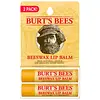What's inside
What's inside
 Key Ingredients
Key Ingredients

 Benefits
Benefits

 Concerns
Concerns

 Ingredients Side-by-side
Ingredients Side-by-side

Hydrogenated Polydecene
EmollientCocoglycerides
EmollientEthylene/Propylene/Styrene Copolymer
Dimethicone
EmollientBrassica Glycerides
EmollientPersea Gratissima Oil
Skin ConditioningGlyceryl Behenate
EmollientMicrocrystalline Cellulose
AbsorbentPolyhydroxystearic Acid
EmulsifyingJojoba Esters
EmollientHelianthus Annuus Seed Wax
Skin ConditioningTheobroma Cacao Seed Butter
EmollientPrunus Amygdalus Dulcis Oil
Skin ConditioningButyrospermum Parkii Butter
Skin ConditioningSilica Silylate
EmollientSilica
AbrasiveCera Alba
EmollientChamomilla Recutita Flower Extract
MaskingRaspberry Seed Oil/Tocopheryl Succinate Aminopropanediol Esters
Skin ConditioningDimethicone Crosspolymer
Emulsion StabilisingDimethicone/Vinyl Dimethicone Crosspolymer
Skin ConditioningAloe Barbadensis Leaf Extract
EmollientCocos Nucifera Oil
MaskingGlyceryl Rosinate
PerfumingHydrogenated Vegetable Oil
EmollientOlea Europaea Oil Unsaponifiables
Skin ConditioningAcacia Decurrens Flower Cera
EmollientTocopherol
AntioxidantButylene/Ethylene/Styrene Copolymer
Euphorbia Cerifera Wax
Polysorbate 80
EmulsifyingPolyglycerin-3
HumectantLinoleic Acid
CleansingHydrolyzed Corn Starch
HumectantSucralose
Skin ConditioningAroma
Linolenic Acid
CleansingHydrated Silica
AbrasivePentaerythrityl Tetra-Di-T-Butyl Hydroxyhydrocinnamate
AntioxidantHydrogenated Polydecene, Cocoglycerides, Ethylene/Propylene/Styrene Copolymer, Dimethicone, Brassica Glycerides, Persea Gratissima Oil, Glyceryl Behenate, Microcrystalline Cellulose, Polyhydroxystearic Acid, Jojoba Esters, Helianthus Annuus Seed Wax, Theobroma Cacao Seed Butter, Prunus Amygdalus Dulcis Oil, Butyrospermum Parkii Butter, Silica Silylate, Silica, Cera Alba, Chamomilla Recutita Flower Extract, Raspberry Seed Oil/Tocopheryl Succinate Aminopropanediol Esters, Dimethicone Crosspolymer, Dimethicone/Vinyl Dimethicone Crosspolymer, Aloe Barbadensis Leaf Extract, Cocos Nucifera Oil, Glyceryl Rosinate, Hydrogenated Vegetable Oil, Olea Europaea Oil Unsaponifiables, Acacia Decurrens Flower Cera, Tocopherol, Butylene/Ethylene/Styrene Copolymer, Euphorbia Cerifera Wax, Polysorbate 80, Polyglycerin-3, Linoleic Acid, Hydrolyzed Corn Starch, Sucralose, Aroma, Linolenic Acid, Hydrated Silica, Pentaerythrityl Tetra-Di-T-Butyl Hydroxyhydrocinnamate
 Reviews
Reviews

Ingredients Explained
These ingredients are found in both products.
Ingredients higher up in an ingredient list are typically present in a larger amount.
Cera alba is beeswax, or the wax used by bees to make honeycombs. It is a texture-enhancer and emollient. A study from 2003 found beeswax to be a stronger emollient than ingredients such as petroleum jelly.
As an emollient, beeswax helps hydrate the skin by creating a barrier on top. This barrier traps moisture in.
Emulsifiers help prevent ingredients from separating. This helps create consistent texture.
The structure of beeswax is mainly long-chain alcohols and the esters of fatty acids.
There are three types of beeswax: yellow, white, and absolute. Yellow is pure beeswax taken from the honeycomb. White beeswax is created by filtering or bleaching yellow beeswax. Absolute beeswax is created by treating beeswax with alcohol. Beeswax used in cosmetics are purified.
Beeswax has been used throughout history and even in prehistoric times. Some common uses for beeswax still used today are making candles, as a waterproofing agent, and polish for leather.
Learn more about Cera AlbaCocos Nucifera Oil is obtained from the kernels of the coconut fruit. In other words, this is coconut oil.
Coconut Oil is rich in fatty acids with lauric acid making up the majority of these. It also contains linoleic acid. Due to this high fatty acid content, coconut oil helps trap moisture and soften skin.
Despite being antibacterial, coconut oil may not be great for acne-prone skin. It is comedogenic and may clog pores. This ingredient may not be safe for malassezia or fungal acne.
Note: Coconut Oil should not replace your sunscreen for UV protection. Studies show it only blocks about 20% of UV.
This oil is non-volatile and has a light scent.
The term 'fragrance' is not regulated in many countries. In many cases, it is up to the brand to define this term. For instance, many brands choose to label themselves as "fragrance-free" because they are not using synthetic fragrances. However, their products may still contain ingredients such as essential oils that are considered a fragrance.
Learn more about Cocos Nucifera OilTocopherol (also known as Vitamin E) is a common antioxidant used to help protect the skin from free-radicals and strengthen the skin barrier. It's also fat soluble - this means our skin is great at absorbing it.
Vitamin E also helps keep your natural skin lipids healthy. Your lipid skin barrier naturally consists of lipids, ceramides, and fatty acids. Vitamin E offers extra protection for your skin’s lipid barrier, keeping your skin healthy and nourished.
Another benefit is a bit of UV protection. Vitamin E helps reduce the damage caused by UVB rays. (It should not replace your sunscreen). Combining it with Vitamin C can decrease sunburned cells and hyperpigmentation after UV exposure.
You might have noticed Vitamin E + C often paired together. This is because it is great at stabilizing Vitamin C. Using the two together helps increase the effectiveness of both ingredients.
There are often claims that Vitamin E can reduce/prevent scarring, but these claims haven't been confirmed by scientific research.
Learn more about Tocopherol